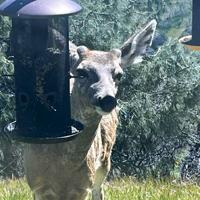
Diane and Alvin Aronson submitted this photo of a California Mule Deer buck that was helping himself to birdseed from a feeder.
The photo was taken earlier this year when the buck’s antlers were just emerging and still in velvet.
Birdseed mixes, which typically consists of seeds like millet, milo, sunflower, cracked corn, etc., are not deer’s favorite foods, but they will sometimes sample these offerings. They typically start by eating the seeds that have fallen to the ground, and then follow the source up to the bird feeders, standing on their back legs to reach the feeders if they have to.
This has been a good year for California Mule Deer in our area, thanks to an abundant wet winter and a cool spring and summer, coupled with nearly five inches of rain in August that brought up green grass that normally wouldn’t be seen until perhaps December.
Drought is especially hard on herbivores that depend on rainfall to bring up the grasses and forbs that they rely on, and Southern California has experienced a lot of drought in the past 20 years. Happily, forecasters are currently predicting an El Nino winter for California, bringing the potential of another wet winter.
In the case of dry years, deer in the Tehachapi Mountains are often able to supplement their diets by grazing on lawns in outlying areas or, less popularly among the homeowners, on ornamental trees, shrubs, flowers and fruit.
The Nuwä (Kawaiisu or Southern Paiute) word for deer is tühui, pronounced tuh-HOO-ee.
NATURAL SIGHTINGS is a regular feature of the Tehachapi News edited by Jon Hammond which showcases photos of the natural beauty that enhances the quality of life in Tehachapi. If you have a good quality image of plants, animals, insects, trees, birds, weather phenomena, etc., taken in the Tehachapi area, you may submit it to the Tehachapi News for possible publication. Submissions can be dropped by the News office in the form of a print or CD, or sent by email to: [email protected].
